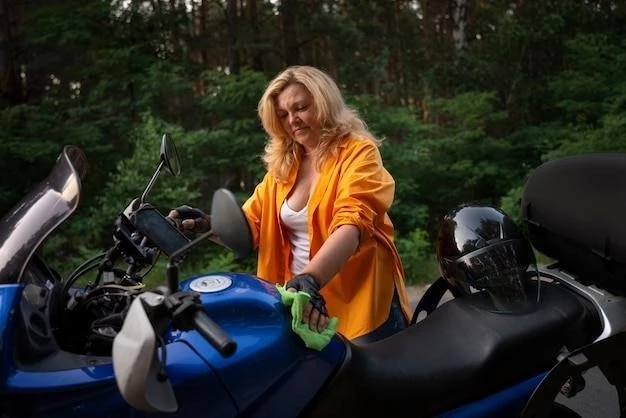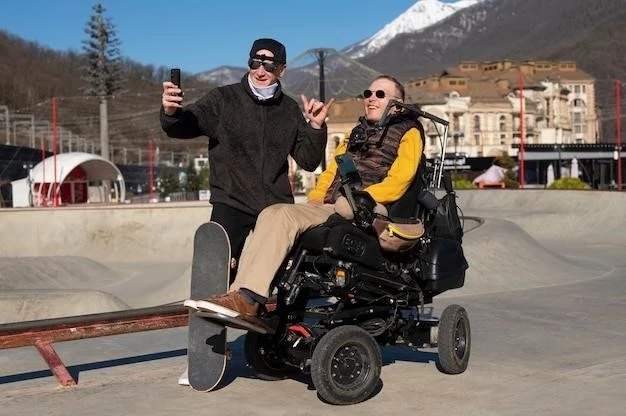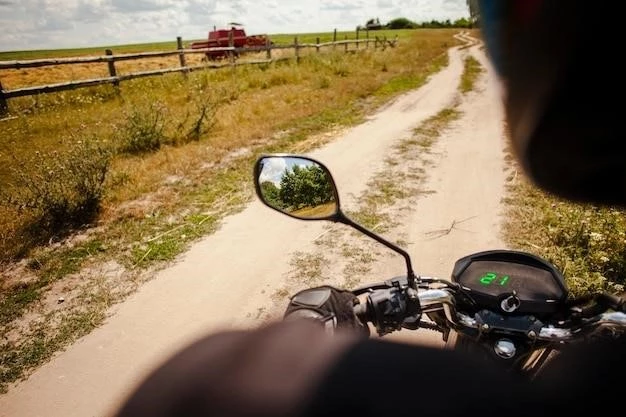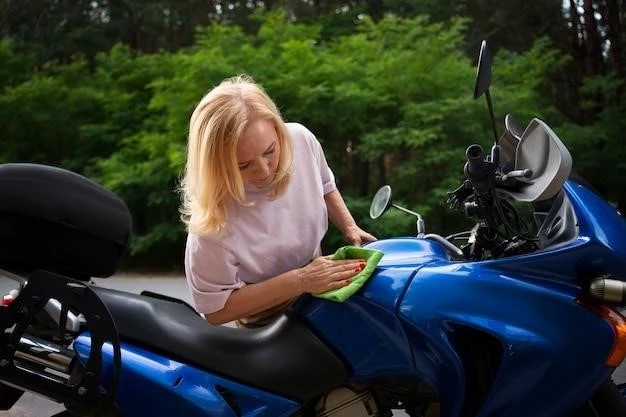Preparation and Planning
Embarking on a motorcycle road trip in 2024 requires meticulous preparation and planning. Before you hit the open road٫ take the time to thoroughly assess your motorcycle’s condition; A comprehensive inspection٫ including the T-CLOCS checklist٫ will help ensure your bike is mechanically sound and ready for the journey ahead. Remember٫ a well-maintained motorcycle is crucial for a safe and enjoyable trip.

Choosing the Right Motorcycle
The open road beckons, and the allure of a motorcycle road trip is undeniable. Yet, before you succumb to the romance of the journey, a crucial decision awaits: selecting the right motorcycle. The ideal machine for your adventure is deeply personal, contingent upon your riding style, the intended route, and the duration of your trip. Let’s delve into the factors that will guide you in making this pivotal choice.
2.1 Consider Your Riding Style and Experience
Are you a seasoned rider, comfortable with the demands of a powerful cruiser or a nimble sportbike? Or perhaps you’re a newer enthusiast, seeking the versatility of a touring-oriented adventure bike? Your riding experience and preferred style should heavily influence your motorcycle selection. Long hours in the saddle demand comfort and ergonomics tailored to your physique and riding habits.
2.2 Factor in Your Route and Terrain
The terrain you plan to conquer will play a significant role in determining the ideal motorcycle. Will you be carving through winding mountain passes, cruising along endless highways, or venturing off the beaten path onto gravel roads and trails? Sportbikes excel on paved roads, while adventure bikes, with their long-travel suspension and rugged design, are more adept at handling diverse terrain. Cruisers offer comfort for long stretches but might be less suited for off-road excursions.
2.3 Evaluate Luggage Capacity and Storage
Extended motorcycle trips necessitate carrying essential gear, camping equipment (if applicable), and personal belongings. Assess the luggage capacity of your chosen motorcycle or its compatibility with aftermarket luggage systems. Touring motorcycles often come equipped with spacious saddlebags and top cases, while other models might require additional racks or luggage solutions.
2.4 Prioritize Comfort and Ergonomics
Comfort is paramount, especially on long rides. Pay close attention to the motorcycle’s seat comfort, riding position, and handlebar placement. An adjustable windscreen can significantly reduce wind fatigue, and features like cruise control can enhance comfort on those endless highway stretches. Remember, a comfortable rider is a safer and more attentive rider.
2.5 Don’t Overlook Reliability and Fuel Efficiency
A reliable motorcycle is essential for a worry-free journey. Research the make and model’s reputation for reliability and consider factors like fuel efficiency, especially if your route involves long distances between fuel stops. Regular maintenance and pre-trip inspections are crucial, but choosing a motorcycle known for its dependability can provide peace of mind.
Essential Gear and Packing List
Equipping yourself with the right gear is paramount for a safe and enjoyable motorcycle road trip. From protective gear to essential tools and clothing for all weather conditions, a well-thought-out packing list is your key to a successful adventure. Let’s break down the essential categories:
3.1 Safety Gear: Non-Negotiable Essentials
Safety should be your foremost concern. Never compromise on quality safety gear, as it provides crucial protection in case of an unexpected event. Your essential safety gear includes:
- Helmet: A well-fitted, DOT-approved helmet is non-negotiable, offering head protection in the event of a fall.
- Eye Protection: Shatterproof goggles or a full-face helmet with a visor will shield your eyes from debris, wind, and insects.
- Riding Jacket: Choose a durable riding jacket specifically designed for motorcyclists, ideally with armor in the shoulders, elbows, and back.
- Riding Pants: Sturdy riding pants made from abrasion-resistant materials like leather or Cordura offer protection for your lower body.
- Gloves: Motorcycle-specific gloves with reinforced palms and knuckle protection enhance grip and safeguard your hands.
- Boots: Sturdy, over-the-ankle boots provide ankle support and protect your feet from injuries.
3.2 Riding Gear for Comfort and Convenience
Enhancing your riding comfort can significantly improve your overall experience. Consider packing these items:
- Base Layers: Moisture-wicking base layers help regulate body temperature in varying weather conditions.
- Warm Layers: Pack a fleece jacket or a lightweight down jacket, even in warmer months, as temperatures can fluctuate.
- Rain Gear: A waterproof jacket and pants are essential for riding in wet conditions, keeping you dry and comfortable.
- Ear Plugs: Earplugs can reduce wind noise, especially on long rides, helping to prevent fatigue.
- Sunscreen and Lip Balm: Protect your skin from the sun’s harmful rays with a high-SPF sunscreen and lip balm.
3.3 Packing for Diverse Weather Conditions
Weather can be unpredictable, so pack for a range of conditions. Layering your clothing allows for adaptability, and quick-drying materials are essential for staying comfortable. Don’t forget items like a rain cover for your motorcycle seat and waterproof bags for your gear.
3.4 Tools, Spares, and Emergency Supplies
Be prepared for minor mechanical issues by carrying a basic tool kit, spare tire repair kit, and a first-aid kit. A flashlight, a multi-tool, and duct tape can also prove invaluable in a pinch. Consider packing a portable phone charger for emergencies.

3.1 Safety Gear
When embarking on a motorcycle road trip, safety should be your paramount concern. Your safety gear is your ultimate line of defense in the unfortunate event of an accident, protecting you from potential injuries. Never compromise on the quality or fit of your safety gear. Remember, it’s an investment in your well-being.
3.1.1 Helmet: Your Essential Shield
A well-fitted, DOT-approved helmet is non-negotiable. It’s your primary protection against head injuries in a crash. Choose a helmet designed for motorcycle riding, ensuring it meets safety standards and fits snugly without obstructing your vision. Consider features like a face shield or visor for added protection from wind, debris, and insects.
3.1.2 Eye Protection: Shielding Your Vision
Protecting your eyes from wind, dust, debris, and insects is crucial for maintaining clear vision while riding. If your helmet doesn’t have a built-in visor, invest in a pair of shatterproof goggles or riding glasses that provide adequate coverage and UV protection.
3.1.3 Riding Jacket: Armour for Your Upper Body
A motorcycle-specific riding jacket is designed to protect your upper body from abrasions and impact in a crash. Look for jackets with built-in armor in the shoulders, elbows, and back. Leather jackets offer excellent abrasion resistance, while textile jackets often incorporate waterproof membranes and ventilation features for added comfort.
3.1.4 Riding Pants: Protecting Your Lower Body
Similar to riding jackets, motorcycle-specific pants are constructed from abrasion-resistant materials and often include armor in the hips and knees. Choose pants that fit comfortably and allow for freedom of movement while riding.
3.1.5 Gloves: Enhancing Grip and Protection
Motorcycle gloves with reinforced palms and knuckle protection provide a secure grip on the handlebars and protect your hands in a fall. Choose gloves that fit snugly and offer adequate dexterity for operating the motorcycle’s controls.
3.1.6 Boots: Ankle Support and Foot Protection
Sturdy, over-the-ankle boots provide essential ankle support and protect your feet from injuries. Look for boots with non-slip soles and good ankle protection. Waterproof boots are ideal for riding in wet conditions.
3.2 Riding Gear
While safety gear is paramount, enhancing your riding comfort can significantly improve your overall experience on a motorcycle road trip. Long hours in the saddle demand comfortable attire and accessories that cater to varying weather conditions and personal preferences. Here’s a closer look at essential riding gear:
3.2.1 Base Layers: Regulating Body Temperature
Moisture-wicking base layers are essential for regulating body temperature, especially during long rides and in fluctuating weather conditions. They wick away sweat, keeping you dry and comfortable, whether it’s hot or cold. Look for base layers made from breathable, quick-drying fabrics.
3.2.2 Layering for Warmth: Be Prepared for Fluctuations
Even in warmer months, temperatures can drop significantly, especially at higher altitudes or during nighttime riding. Pack a fleece jacket or a lightweight down jacket for added warmth. Layering your clothing allows for adaptability to changing weather conditions.
3.2.3 Rain Gear: Staying Dry in Wet Conditions
Riding in the rain can be uncomfortable and potentially dangerous. A waterproof jacket and pants are essential for staying dry and maintaining visibility. Look for rain gear specifically designed for motorcyclists, with features like reflective elements and a snug fit to prevent flapping in the wind.
3.2.4 Ear Plugs: Reducing Wind Noise Fatigue
Prolonged exposure to wind noise can lead to fatigue and discomfort. Wearing earplugs specifically designed for motorcyclists can significantly reduce wind noise while still allowing you to hear important sounds like sirens or horns.
3.2.5 Sunscreen and Lip Balm: Protecting Your Skin
Long hours on the road expose your skin to the sun’s harmful rays. Pack a high-SPF sunscreen and lip balm to protect yourself from sunburn and windburn. Apply sunscreen to all exposed skin, even on cloudy days.
3.2.6 Neck Gaiter or Balaclava: Versatile Protection
A neck gaiter or balaclava can provide versatile protection from the elements. Wear it as a neck warmer in cold weather, as a face mask in dusty conditions, or as a sweatband under your helmet in hot weather.

3.3 Camping and Accommodation
As you plan your motorcycle road trip, deciding on your accommodation style will shape the overall experience. Will you embrace the freedom of camping under the stars or opt for the comfort of motels and hotels? Each approach offers a unique perspective on the journey.
3.3.1 Camping: Embracing the Great Outdoors
Camping allows you to immerse yourself in nature, waking up to stunning vistas and the sounds of the wilderness. However, it requires careful planning and packing. Here’s a list of camping essentials:
- Tent: Choose a tent that’s easy to set up and provides adequate space for your needs.
- Sleeping Bag: Select a sleeping bag rated for the expected temperatures, ensuring a comfortable night’s sleep.
- Sleeping Pad: A sleeping pad provides insulation and cushioning from the ground, enhancing sleep quality.
- Cooking Gear: If you plan to cook your own meals, pack a portable stove, fuel, cooking utensils, and a mess kit.
- Camp Lighting: A headlamp or lantern is essential for navigating around the campsite at night.
- Camp Chair: A comfortable camp chair provides a place to relax and enjoy the scenery.
3.3.2 Motels and Hotels: Comfort and Convenience
Motels and hotels offer a more comfortable and convenient option, especially after a long day of riding. You’ll have access to amenities like a comfortable bed, private bathroom, and often a swimming pool or restaurant. When booking accommodations, consider:
- Location: Choose accommodations located along your planned route or near points of interest.
- Budget: Set a budget for accommodation and explore options that fit your price range.
- Amenities: Consider amenities that are important to you, such as Wi-Fi, parking, or breakfast.
- Reviews: Read online reviews from fellow travelers to get an idea of the quality and service of different accommodations;
3.3.3 Combination Approach: The Best of Both Worlds
Many motorcycle road trippers opt for a combination of camping and motel stays. This approach allows you to experience the beauty of camping while also enjoying the comfort and convenience of a motel when needed. You can plan your itinerary to include a mix of both options.
3.4 Tools and Spares
While embarking on a motorcycle road trip is undeniably exhilarating, it’s essential to be prepared for unexpected mechanical hiccups. Carrying a well-equipped tool kit and essential spare parts can empower you to address minor issues and continue your adventure with minimal disruption. Here’s a comprehensive guide to essential tools and spares:
3.4.1 Essential Tools for Roadside Repairs
A compact yet comprehensive tool kit is invaluable for addressing common mechanical issues. Consider packing these essential tools:
- Wrenches: A set of metric wrenches in various sizes will cover most common bolt and nut sizes on your motorcycle.
- Screwdrivers: Pack a set of both Phillips and flat-head screwdrivers in various sizes.
- Allen Keys: A set of Allen keys, also known as hex keys, is essential for working with fasteners found on many motorcycles.
- Pliers: Include a pair of adjustable pliers, needle-nose pliers, and wire cutters for gripping, bending, and cutting wires.
- Tire Repair Kit: A tire repair kit, including plugs, patches, and tools for removing and inserting them, is essential for addressing punctures.
- Air Pump: A compact air pump, either hand-powered or electric, is crucial for reinflating a tire after a repair.
3.4;2 Spare Parts for Peace of Mind
Carrying essential spare parts can save you time and hassle should a minor breakdown occur. Consider packing these items:
- Spare Tire Tubes: Carrying at least one spare tire tube for each tire size on your motorcycle is highly recommended.
- Fuses: Pack an assortment of fuses that match your motorcycle’s specifications.
- Light Bulbs: Carry spare bulbs for your headlight, taillight, and turn signals.
- Duct Tape: Duct tape can be a lifesaver for temporary repairs to hoses, wires, or even bodywork.
- Cable Ties: Cable ties are useful for securing loose wires or hoses.
3.4.3 Motorcycle-Specific Tools and Manuals
Consult your motorcycle’s owner’s manual for any specific tools or spare parts recommended by the manufacturer. Some motorcycles require unique tools for adjustments or repairs.

Route Planning and Navigation
The allure of the open road is undeniable, but embarking on a motorcycle road trip without a well-defined route is akin to setting sail without a chart. Meticulous route planning and reliable navigation tools are the compass and map that will guide your adventure, ensuring you make the most of every mile.
4.1 Mapping Your Course: Choosing Your Route
The first step in route planning is to define your destination and identify potential points of interest along the way. Consider these factors when crafting your route:
- Scenery and Landscapes: Are you drawn to winding mountain roads, coastal highways, or desolate desert landscapes? Tailor your route to your scenic preferences.
- Points of Interest: Incorporate stops at national parks, historical landmarks, or charming towns that pique your interest.
- Riding Time and Distance: Balance your desire for exploration with realistic daily riding limits to avoid fatigue and maximize enjoyment.
- Road Conditions: Research road conditions along your planned route, considering factors like traffic, construction, and weather-related closures.
4.2 Navigation Tools: Guiding Your Way
In today’s digital age, a plethora of navigation tools are at your disposal. Consider these options:
- GPS Navigation Devices: Dedicated motorcycle GPS units offer features tailored for riders, such as weather alerts, Bluetooth connectivity, and ruggedized construction.
- Smartphone Navigation Apps: Smartphone apps like Google Maps and Waze provide turn-by-turn directions, real-time traffic updates, and points of interest along your route.
- Paper Maps: While digital navigation is convenient, carrying paper maps as a backup is always wise, especially in areas with limited cell service.
4.3 Staying Found: Essential Navigation Tips
Ensure a smooth and stress-free journey with these navigation tips:
- Pre-Program Your Route: Input your destination and waypoints into your chosen navigation device before you set off.
- Charge Your Devices: Ensure your GPS unit or smartphone is fully charged before each day’s ride.
- Take Breaks: Regular breaks not only combat fatigue but also provide opportunities to review your route and make adjustments as needed.
4.1 Motorcycle-Friendly Routes
The open road holds a particular allure for motorcyclists, offering a sense of freedom and adventure unmatched by any other mode of transportation. However, not all roads are created equal when it comes to two-wheeled adventures. Choosing motorcycle-friendly routes can significantly enhance your riding experience, leading you on scenic byways, winding mountain passes, and captivating coastal highways.
4.1.1 Identifying Motorcycle-Friendly Roads
Several factors contribute to a road’s suitability for motorcycles. Look for routes that offer:
- Scenic Beauty: Motorcycle rides are best enjoyed when surrounded by captivating scenery. Seek out routes that wind through picturesque landscapes, offering stunning vistas, towering forests, or sparkling coastlines.
- Twisting Turns and Elevation Changes: For many riders, the thrill of the ride lies in navigating winding roads and challenging curves. Look for routes with elevation changes, switchbacks, and sweeping turns that will test your skills and provide an adrenaline rush.
- Smooth Pavement: While some riders enjoy the challenge of unpaved roads, smooth pavement is generally preferable for a comfortable and enjoyable ride. Avoid routes with excessive potholes, rough surfaces, or gravel sections unless you’re specifically seeking an off-road adventure.
- Light Traffic: Sharing the road with heavy traffic can detract from the enjoyment of a motorcycle ride. Opt for routes known for lighter traffic flow, allowing you to ride at your own pace and soak in the surroundings.
4.1.2 Resources for Finding Motorcycle-Friendly Routes
Fortunately, numerous resources are available to help you discover epic motorcycle routes tailored to your preferences. Consider exploring:
- Motorcycle Magazines and Websites: Publications like “Rider Magazine” and websites like “MotorcycleRoads.com” often feature curated motorcycle routes with detailed descriptions, maps, and rider reviews.
- Motorcycle Forums and Online Communities: Connect with fellow riders in online forums and communities to gather recommendations for scenic and motorcycle-friendly routes in specific regions.

4.2 Navigation Tools and Apps
In today’s digitally connected world, navigating unfamiliar roads and discovering hidden gems along your motorcycle road trip is easier than ever, thanks to a plethora of navigation tools and apps designed specifically for riders. These technological companions provide turn-by-turn directions, real-time traffic updates, points of interest, and even weather forecasts, ensuring you stay on course and make the most of your journey.
4.2.1 Dedicated Motorcycle GPS Units
Motorcycle GPS units are purpose-built for the rigors of two-wheeled adventures. They offer features like:
- Ruggedized Construction: Designed to withstand vibrations, impacts, and weather conditions typically encountered on motorcycles.
- Bluetooth Connectivity: Pair with your smartphone or helmet communication system for hands-free calling, music streaming, and turn-by-turn directions through your helmet speakers.
- Motorcycle-Specific Maps: Preloaded with maps optimized for motorcycle routes, including scenic byways, points of interest, and motorcycle-friendly businesses.
- Weather Alerts: Receive real-time weather updates and alerts along your route, allowing you to adjust your plans accordingly.
4.2.2 Smartphone Navigation Apps
Smartphone apps like Google Maps and Waze offer a convenient and cost-effective alternative to dedicated GPS units. Benefits include:
- Real-Time Traffic Updates: Receive up-to-the-minute traffic information, helping you avoid congestion and delays.
- Points of Interest: Easily search for gas stations, restaurants, hotels, and attractions along your route.
- Offline Maps: Download maps for offline use in areas with limited or no cell service.
- Voice Guidance: Receive turn-by-turn directions through your smartphone’s speaker or Bluetooth headset.
4.2.3 Paper Maps: A Reliable Backup
While digital navigation is incredibly convenient, it’s always wise to carry paper maps as a backup, especially in remote areas with limited cell service. Familiarise yourself with basic map reading skills before your trip.
Budgeting and Expenses
While the allure of the open road and the promise of adventure are at the heart of every motorcycle road trip, it’s essential to approach your journey with a realistic budget in mind. Unexpected expenses can arise, and careful financial planning ensures you can fully embrace the experience without exceeding your financial limits. Let’s break down the key expense categories and explore strategies for cost-effective travel.
5.1 Pre-Trip Expenses: Setting the Financial Stage
Before you even hit the road, certain pre-trip expenses warrant consideration:
- Motorcycle Maintenance and Repairs: Ensure your bike is in top mechanical condition with a thorough pre-trip inspection, addressing any necessary repairs or maintenance.
- Gear and Accessories: Invest in quality safety gear, riding gear, and any necessary accessories, such as luggage systems or navigation tools.
- Trip Insurance: Protect yourself and your investment with comprehensive motorcycle insurance, including coverage for medical expenses, trip cancellation, and motorcycle damage or theft.
5.2 On-the-Road Expenses: Fueling Your Adventure
As you embark on your journey, anticipate these ongoing expenses:
- Fuel Costs: Fuel consumption can vary significantly depending on your motorcycle’s fuel efficiency and your riding style. Factor in fuel costs based on current gas prices and your planned mileage.
- Accommodation: Budget for nightly accommodation, whether you choose campgrounds, motels, or a combination of both.
- Food and Beverages: Allocate funds for meals, snacks, and beverages, considering whether you’ll dine out or prepare some of your own meals.
- Activities and Attractions: Include a budget for any planned activities, such as national park entrance fees, museum admissions, or guided tours.
5.3 Strategies for Cost-Effective Travel: Stretching Your Budget
Traveling on a budget doesn’t mean sacrificing the quality of your experience. Consider these strategies to make your motorcycle road trip more affordable:










